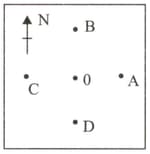Magnetic Field due to a Current Carrying Conductor
Magnetic Field due to a Current Carrying Conductor: Overview
This topic covers concepts, such as Magnetic Field Due to a Current, Biot-Savart Law, Permeability of Free Space, Direction of Magnetic Field Using Right Hand Thumb Rule, Magnetic Field Due to a Straight Infinite Wire, Magnetic Field on the Axis of a Circular Current Loop, Magnetic Field on the Centre of a Circular Current Loop, Magnetic Field on the Axis of a Current Carrying Solenoid, Ampere's Circuital Law & Magnetic Field Due to Toroid Using Ampere's Law etc.
Important Questions on Magnetic Field due to a Current Carrying Conductor
Two wires A and B have lengths and respectively. A is bent as a circle of radius and B into an arc of radius . A current is passed through A and through B. To have same magnetic field at the centre, the ratio of : is
Two parallel wires carrying current in opposite directions
S.I. unit of magnetic field is
Consider point A, B, C, D on a horizontal cardboard equidistant from centre O as shown in the figure. A copper wire perpendicular to the cardboard passes through the centre O and carries an electric current flowing upwards. Deflection of magnetic needle will be maximum when it is kept at the point.
Three rings P, Q, and Rare dropped at the same time over identical hollow magnets as shown below: Which of the following describes the order in which the rings P, Q, and R reach the bottom of the magnet?
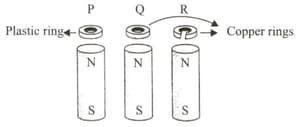
A coil carrying current behaves as a/an
A fuse wire is always connected to the
If current in the coil decreases, the strength of the magnetic field
By increasing the number of turns in the coils, the strength of the magnetic field
Currents 2I and I flow in the directions shown through the x and y wires in the figure given below.
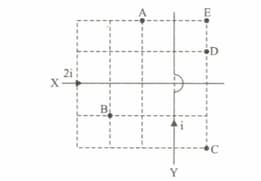
So at what point is the resultant magnetic field zero?

Electric currents pass through the X, Y, Z and T wires perpendicular to the plane of the page in the directions and values shown in the figure. The magnitude of the magnetic field formed by X and Y at point K is BK, the magnitude of the magnetic field created by Z and T in L is BL. So what is the ratio of ?
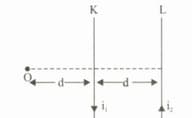
The magnitude of the resultant magnetic field at point O of the K and L. wires on the plane of the page that passes |1, and I2, currents is -B.
Since the magnitude of the magnetic field of only K wire at point O is B, what is the ratio of ?
If magnetic field at L because of wire X is B then what is effective intensity L due to both the wires?
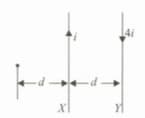
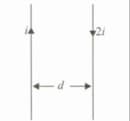
Two parallel wires lying in plane of paper are carrying current I and 2I and are placed at distance d. At what distance we can find the point where the net magnetic field due to two wire in the figure will be zero?
Wire X, Y are carrying current i and 3i respectively as per information given in the diagram. At which of point the net magnetic field to be zero?
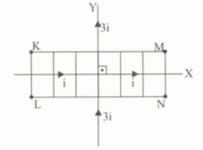
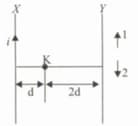
Two wires X and Y are lying parallel in the plane of paper as shown In diagram given below. What will be current through Y such that net intensity of magnetic field at K is zero?
Four wires at X, Y, Z and T are carrying current into plane of paper. If magnetic field at O because of X wire is B and the net magnetic field is kB. What is the value of k?
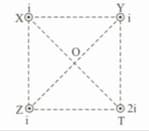
At which of the point net Magnetic effect due to two wires is zero.
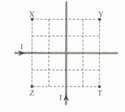
The current intensities passing over the K and L wires placed on the plane of the page as in the figure are 2I and 3I, respectively. The resultant magnetic field they form together at the X point is B.
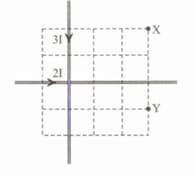
Accordingly, what is the resultant magnetic field at the Y point?
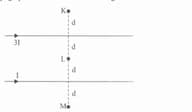
3I and I currents parallel to each other on the page plane are as shown in the figure. The resultant magnetic fields formed at the K, L, M points, respectively; BK BL BM. Which of the following ts the order of magnitude of the magnetic fields in K, L, M?

